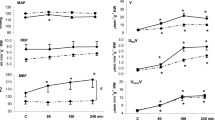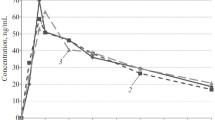Summary
The responses of plasma renin activity (PRA) and plasma catecholamine levels to molsidomine, administered both intravenously and orally, were investigated in conscious trained dogs.
Intravenous administration of molsidomine at increasing dosage up to 0.4 mg/kg with a constant dose interval of 4 hours did not lead to a sustained increase in PRA. By contrast, a significant increase in PRA was still present after 4 hours on administration of 0.4 mg/kg molsidomine by the oral route. This longer-lasting increase in PRA following oral administration is discussed in relation to the conversion of molsidomine to an active metabolite in the liver. A reduction of dose interval to 3 hours or less led to a marked cumulative increase in PRA.
It appears that substances acting via venous pooling lead to persistent activation of the renin angiotensin aldosterone system (RAA system), which counteracts its primary therapeutic effect. A slight increase in plasma noradrenaline levels was observed in response to repeated oral administration of 0.4 mg/kg molsidomine at a dose interval of 2 hours, indicating participation of the sympathetic nervous system in the counterregulatory process.
Zusammenfassung
Die Wirkung intravenöser und peroraler Gaben von Molsidomin auf die Plasmareninaktivität (PRA) und die Plasmakatecholaminspiegel wacher Hunde wurde untersucht.
Intravenöse Verabreichung von Molsidomin in einer Dosierung bis zu 0,4 mg/kg bei einem gleichbleibenden Dosisintervall von 4 Stunden führte zu keinem langanhaltenden Anstieg der PRA. Im Gegensatz dazu war nach peroraler Verabreichung von 0,4 mg/kg Molsidomin nach 4 Stunden die PRA noch deutlich erhöht. Der relativ stärkere Anstieg der PRA auf orale Gabe wird mit Bezugnahme auf den Abbau von Molsidomin zu einem aktiven Metaboliten in der Leber diskutiert. Verkürzung des Dosisintervalls auf 3 Stunden und weniger führte zu einem kumulativen PRA-Anstieg.
Es ist anzunehmen, daß Substanzen, die venöses Pooling verursachen, zu einer andauernden Aktivierung des Renin-Angiotensin-Aldosteron-Systems (RAA-System) führen, welche dem ursprünglichen therapeutischen Effekt entgegenwirkt. Der geringe Anstieg der Plasmanoradrenalinwerte, der nach peroraler Gabe von 0,4 mg/kg Molsidomin bei einem Dosisintervall von 2 Stunden beobachtet wurde, deutet die Mitbeteiligung des Sympathischen Nervensystems bei der Gegenregulation an.
Similar content being viewed by others
References
Abukhres, M. M., R. J. Ertel, B. N. Dixit, R. R. Vollmer: Role of the reninangiotensin system in the blood pressure rebound to sodium nitroprusside in the conscious rat. Europ. J. Pharmacol.58, 247–254 (1979).
Bassenge, E., J. Holtz. Hamodynamische und kardiale Wirkungen von Molsidomin beim wachen Hund. In: Molsidomin (1. Molsidomin-Symposium München 1978), Hrsg. W. Lochner, F. Bender. Urban & Schwarzenberg (Munchen-Wien-Baltimore 1979).
Benke, Th., O. Kraupp, P. Placheta, B. Stanek, G. Raberger: The effect of single and repeated doses of isosorbide dinitrate on plasma renin activity and plasma catecholamine levels in conscious dogs. Basic Res. Cardiol.75, 400–409 (1980).
Brennan, L. A., Jr., R. L. Malvin, K. E. Jochim, D. E. Roberts: Influence of right and left atrial receptors on plasma concentrations of ADH and renin. Amer. J. Physiol.221, 273–278 (1971).
Brown, J. J., D. L. Davies, A. F. Lever, J. I. S. Robertson, A. Verniory: The effect of acute haemorrhage in the dog and man on plasma renin concentration. J. Physiol.182, 649–663 (1966).
Brown, T. C., J. O. Davis, C. I. Johnston: Acute response in plasma renin and aldosterone secretion to diuretics. Amer. J. Physiol.211, 437–441 (1966).
Da Prada, M., G. Zürcher: Simultaneous radioenzymatic determination of plasma and tissue adrenaline, noradrenaline and dopamine within the femtomole range. Life Sciences19, 1161–1174 (1976).
Fiedler, V. B., J. Scholtholt: Haemodynamic Effects of Molsidomine. Arzneim.-Forsch. (Drug Res.)28, 1605–1612 (1978).
Fleck, E., J. Dirschinger, W. Rudolph: Segmentale Ventrikelwandbewegung und regionale Myokarddurchblutung unter dem Einfluß von Molsidomin bei Patienten mit koronarer Herzerkrankung. In: Molsidomin (1. Molsidomin-Symposium München 1978), Hrsg. W. Lochner, F. Bender. Urban & Schwarzenberg (München-Wien-Baltimore 1979).
Goetz, K. L., B. C. Wang, M. O. K. Hakumäki, D. C. Fater, P. G. Geer, W. D. Sundet: Cardiovascular, Renal, and Humoral Effects of Applying Local Anesthetic to the Atria of Conscious Dogs. Proc. Soc. Exp. Biol. Med.167, 101–109 (1981).
Heinzow, B., A. Ziegler: Comparison of the Effects of Nitroglycerin Administered to Rats by Different Routes. J. Cardiovasc. Pharmacol.3, 573–580 (1981).
Haber, E., Th. Koerner, L. B. Page, B. Kliman, A. Purnode. Application of a Radioimmunoassay for Angiotensin I to the Physiologic Measurements of Plasma Renin Activity in Normal Human Subjects. J. Clin. Endocrin.29, 1349–1355 (1969).
Higgins, J. T., Jr., J. O. Davis, J. Urquart, M. J. Olichney: Increased plasma level of renin in experimental secondary hyperaldosteronism. Amer. J. Physiol.207, 814–820 (1964).
Holtz, J., E. Bassenge, A. Kolin: Hemodynamic and myocardial effects of long-lasting venodilation in the conscious dog: Analysis of molsidomine in comparison with nitrates. Basic Res. Cardiol.73, 469–481 (1978).
Packer, M., J. Meller, N. Medina, M. Yushak, R. Gorlin: Determinants of Drug Response in Severe Chronic Heart Failure. 1. Activation of Vasoconstrictor Forces During Vasodilator Therapy. Circulation64, 506–514 (1981).
Pettinger, W. A., K. Keeton: Altered Renin Release and Propranolol Potentiation of Vasodilatory Drug Hypotension. J. Clin. Invest.55, 236–243 (1975).
Sponer, G., K. Dietmann, K. Strein, W. Bartsch: Significance of dosage interval for the development of tolerance to isosorbide-5-mononitrate in conscious dogs. IRCS Medical Science: Physiology9, 619 (1981).
Stanek, B., S. Bacher, Th. Benke, G. Raberger: The effects of isosorbide dinitrate and molsidomine on plasma renin activity (PRA) and plasma catecholamine levels (NA, A) in conscious dogs. Naunyn-Schmiedeberg's Arch. Pharmacol.311, R 43 (1980).
Stanek, B., M. Zimpfer, S. Fitzal, G. Raberger: Plasma Catecholamines, Plasma Renin Activity and Haemodynamics During Sodium Nitroprusside-Induced Hypotension and Additional Beta-Blockade with Bunitrolol. Europ. J. Clin. Pharmacol.19, 317–322 (1981).
Tanamaya, S., Y. Nakai, T. Fujita, Z. Suzuoki, Y. Imashiro, K. Masuda: Biotransformation of Molsidomine (N-Ethoxycarbonyl-3-morpholinosydnonimine), a New Anti-anginal Agent, in Rats. Xenobiotica4, 175–191 (1974).
Thadani, U., H.-L. Fung, A. C. Darke, J. O. Parker: Oral Isosorbide Dinitrate in Angina Pectoris: Comparison of Duration of Action and Dose-Response Relation During Acute and Sustained Therapy. Amer. J. Cardiol.49, 411–419 (1982).
Tukey, J. W.: Comparing individual means in the analysis of variance. Biometrics5, 99–114 (1949).
Ueda, H., Y. Kaneko, T. Takeda, T. Ikeda, S. Yagi: Observations on the Mechanism of Renin Release by Hydralazine in Hypertensive Patients. Circulat. Res.26, Suppl. II, II—201-II—206 (1970).
Watkins, L., Jr., J. A. Burton, E. Haber, J. R. Cant, F. W. Smith, A. C. Barger: The Renin-Angiotensin-Aldosterone System in Congestive Failure in Conscious Dogs. J. clin. Invest.57, 1060–1617 (1976).
Zehr, J. E., J. A. Hasbargen, K. D. Kurz: Reflex Suppression of Renin Secretion during Distension of Cardiopulmonary Receptors in Dogs. Circulat. Res.38, 232–239 (1976).
Author information
Authors and Affiliations
Additional information
A preliminary report of this study has been presented at the 21st Spring Meeting of the Deutsche Pharmakologische Gesellschaft (Naunyn-Schmiedeberg's Arch. Pharmacol. 311, R 43, 1980).
Rights and permissions
About this article
Cite this article
Bacher, S., Kraupp, O., Stanek, B. et al. The effect of repeated intravenous and oral doses of molsidomine (N-carboxy-3-morpholino-sydnonimine-ethylester) on plasma renin activity and plasma catecholamine levels in conscious dogs. Basic Res Cardiol 78, 193–202 (1983). https://doi.org/10.1007/BF01906672
Received:
Issue Date:
DOI: https://doi.org/10.1007/BF01906672




